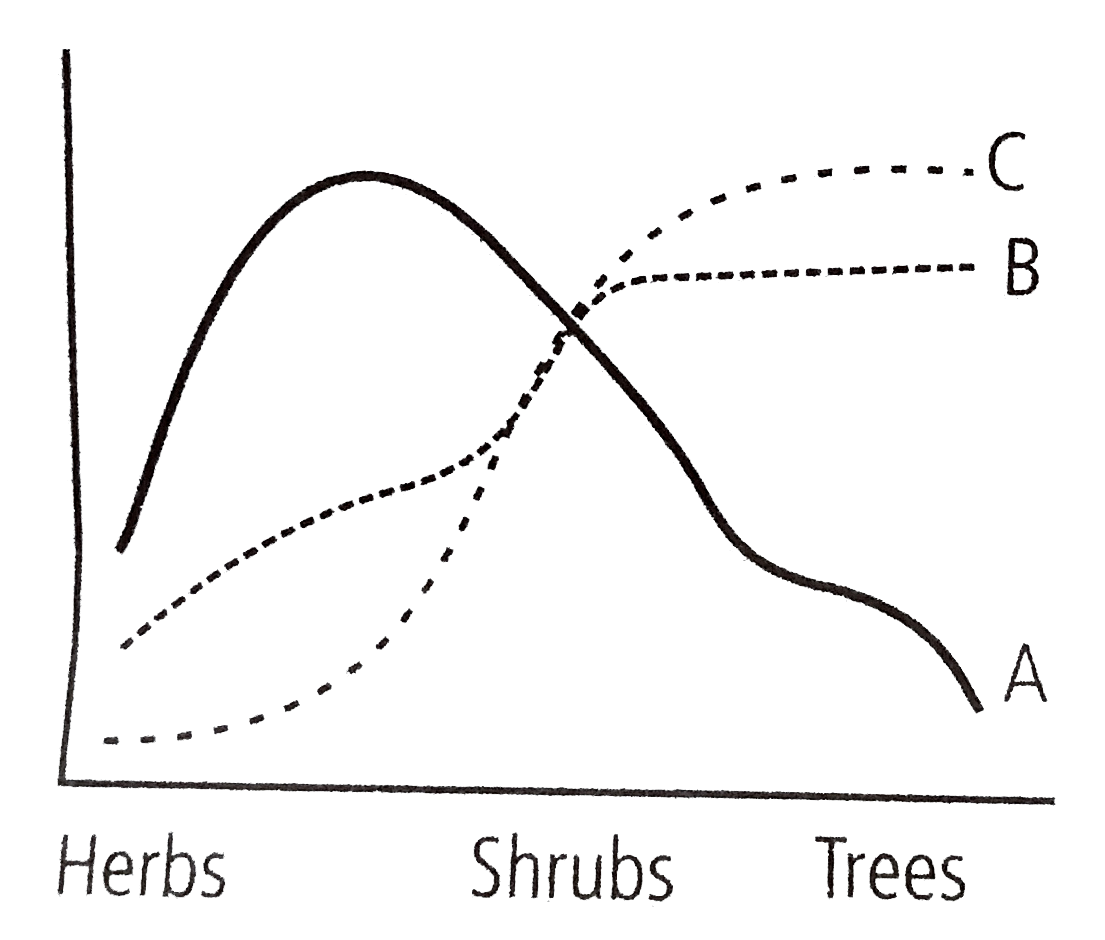Succession in a forest ecosystem is characterised by chnages in species diversity , biomass and net primary productivity as shwon in the graph below, identify curves A,B and C.

A: biomass B: net primary productivity C: species diversity
A: species diversity B: net primary productivity C: biomass
A: net primary productivity B: biomass C: species diversity
A: net primary productivity B: species diversity C: biomass
The correct Answer is:D
Biotic or ecological succession is the natural development of a series of biotic communities at the same, site, one after the other till a climax community develops which does not change further because it is in perfect harmony with the environment of the area. The change is orderly and sequential. At the end of biotic succession, i.e., when climax community has formed, the biomass has reached to the highest of all biotic stages, diversity has grown higher niches are many and specialised. However productivity has decreased as respiratory consumption has increased in the climax community.
Topper's Solved these Questions
- BOOK - NCERT FINGERTPS ENGLISHCHAPTER - ECOSYSTEMEXERCISE - Ecosystem140videos
ECOSYSTEM
- BOOK - NCERT FINGERTPS ENGLISHCHAPTER - BIOTECHNOLOGY AND ITS APPLICATIONEXERCISE - Biotechnology And Its Application137videos
BIOTECHNOLOGY AND ITS APPLICATION
- BOOK - NCERT FINGERTPS ENGLISHCHAPTER - ENVIRONMENTAL ISSUESEXERCISE - Environmental Issues142videos
ENVIRONMENTAL ISSUES
Similar Questions
The rate of synthesis of organic matter by consumers is
(a) net primary productivity
(b) gross primary productivity
(c) standing state
(d) secondary productivityView SolutionThe biomass available for consumption to heterotrophs and the rate formation of new organic matter by consumers are defined as
(a) gross primary productivity and net primary productivity respectively
(b) net primary productivity and gross primary productivity respectively
(c) gross primary productivity and secondary productivity respectively
(d) net primary productivity and secondary productivity respectively.View Solution
Knowledge Check
- Question 1 - Select One
Assertion : Broadly utilitarian arguments say that we should conserve biodiversity because biodiversity plays a major role in many ecosystem services that nature provides.
Reason : Expolration of molecular, genetic and species level diversity to obtain the products of economic importance is include under broadly utilitarian category.
(a) If both assertion and reason are true and reason is the correct explanation of assertion.
(b) If both assertion and reason are true but reason is not the correct explanation of assertion.
(c) If assertion is true but reason is false.
(d) If both assertion and reason are false.AIf both assertion and reason are true and reason is the correct explanation of assertion.BIf both assertion and reason are true but reason is not the correct explanation of assertion.CIf assertion is true but reason is false.DIf both assertion and reason are false. - Question 2 - Select One
The rate at which light energy is converted into chemical energy of organic molecules, is the ecosystem's
(a) net primary productivity
(b) net secondary productivity
(c) gross secondary productivity
(d) gross primary productivityAnet primary productivityBnet secondary productivityCgross secondary productivityDgross primary productivity - Question 3 - Select One
In the tropical rainforest, the majority of trees have showy animal-pollinated flowers. In temperate forests the majority of trees are wind pollinated. Which factors best explain these contrasting patterns ?
(i) Wind is rare in tropical forests.
(ii) Because of high species diversity in the tropics, individuals of trees species are often widely separated making wind an inefficient means of pollen dispersal.
(iii) More opportunities for coevolved mutualisms exist in tropical forests because of the high diversity of animal species.
(iv) Trees in tropical forests are mostly evergreen and year-round leaf canopies impede pollen dispersal by wind.
(v) Flowering in tropical forests occurs over a short period of time when wind is absent.
(a) (i) , (ii) and (v)
(b) (i),(iii) and (v)
(c) (ii), (iii) and (iv)
(d) (ii) and (iv)A(i) , (ii) and (v)B(i),(iii) and (v)C(ii), (iii) and (iv)D(ii) and (iv)
Select the correct combination of statements regarding the characteristics of productivity :
I. The rate of biomass production is called productivity and is expressed in terms of kcal m−2
II. Gross primary productivity is rate of production of biomass during photosynthesis
IIl. Gross primary productivity minus respiration loss is called net primary productivity
IV. Primary productivity depends only on the plant species inhabiting a particular area.
The correct statements areView SolutionIdentify true or false statements. Correct each false statement to make it true.
(i) Number of species in a community really matter to the functioning of the ecosystem.
(ii) David Tilman proved that decreased diversity contributed to higher productivity.
(iii) Rich biodiversity is not essential for ecosystem health but required for survival of human race of earth.
(iv) Species which are dangerously harmful beings and their interests can be thought of deliberate extinction.View SolutionConsider the following four statements (A-D) and select the correct option stating which ones are true (T) and which ones are False (F).
(A) Vertical distribution of different species occupying different levels in a community is called stratification.
(B) Net primary productivity minus respiration losses is the gross primary productivity.
(C) Rate of biomass production is called decompostion.
(D) Annual net primary productivity of oceans is 55 billion tons.View SolutionAlexander von Humboldt is associated with
(a.) species - area relationship
(b.) log S = log C + z logA
(C.) Within a region , species richness increases with the increasing limited explored area.
(d.) Increased diversity contributes to higher productivity.
(e.) Species diversity increases with the loss of keystone species.View SolutionMath List-I with List-II and select the correct answer using the codes given below the lists
List-IList-IIA.The amount of energy accumulation in green plants through the process of photosynthesis1.Gross primary productivityB.The total organic matter synthesized by the producers in the process of photosynthesis per unit time and area2.Primary productivityC.Rate of storage of organic matter in plant tissues in excess of the respiratory utilization during the measurement period3.Secondary productivityD.Rate of energy storage at consumer level4.Net primary productivityView Solution
